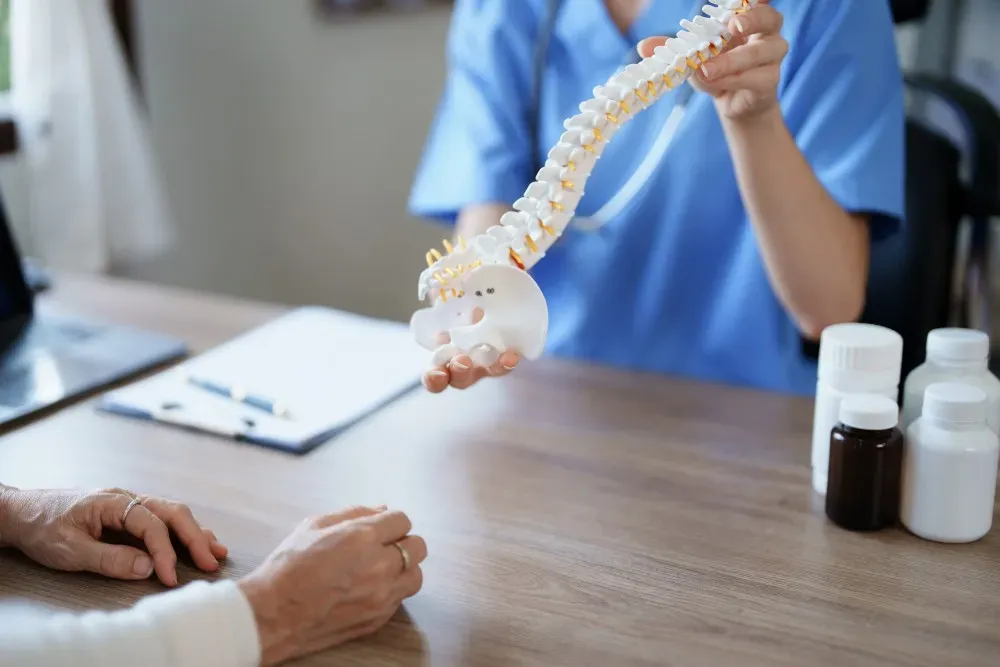Neurosurgery & Orthopedic Surgeons in Jacksonville

What is Whiplash?
More than 1 million Americans suffer whiplash injuries every year and approximately 10% of those people end up with chronic neck pain from the injury.
More than 1 million Americans suffer whiplash injuries every year and approximately 10% of those people end up with chronic neck pain from the injury.
Read our comprehensive guide to learn more about what whiplash is, how the injury occurs and how you can get back on your feet after suffering a neck injury.
DEFINITION AND CAUSES
Whiplash is a neck injury sustained when the neck moves in a forceful, abrupt and unrestrained backward-and-forward motion. The force of the movement strains and tears the ligaments, muscles and tendons in the neck. It can also damage the spine and spinal discs.
The most common cause is rear-end car accidents. If you’re in a stationary position, being hit from behind will cause the neck to jerk forward and back in an unrestrained, unprotected manner. However, other high-impact occurrences can cause injury, including:
- Physical abuse — being shaken or punched
- Collisions in contact sports
- Roller coaster rides
- Horseback riding
- Falls
If you suffer a high-impact accident, see a doctor right away, even if you don’t have any obvious pain or injury at first. Your doctor will take imaging tests like an X-ray and a CT scan to rule out severe damage or fractures to your head, neck and spine.
PRESENTATION OF SYMPTOMS
Symptoms may present immediately after the injury occurs or they may present within 24 hours to a few days after injury. You may experience any of the following:
- Neck pain that worsens with movement
- Neck stiffness
- Loss of range of motion (ROM)
- Pain, tenderness or numbness in the shoulders, upper back or arms
- Jaw pain
- Headaches that start at the base of the skull
- Dizziness
- Fatigue
- Ringing in the ears (tinnitus)
In rarer cases, some people also develop memory issues, difficulty concentrating, anxiety or depression, anger, insomnia and irritability. Symptoms usually persist for several weeks, but early treatment can help speed up the healing process and ensure a full recovery.
DIAGNOSIS
There are no official tests to diagnose whiplash, because soft tissue damage to the muscles and ligaments can’t be viewed on an X-ray. However, your doctor will still take imaging tests like an X-ray and a CT scan to rule out fractures and determine if any other condition (like dislocations, degeneration, inflammation or arthritis) may be a source of your pain.
Symptom expression is the primary factor for making a whiplash diagnosis. Your doctor will ask you detailed questions about how your accident or injury occurred, when symptoms appeared, and the severity of symptoms. He or she may ask you to perform in-office exercises to test ROM, pain points and pain with movement.
COURSE OF TREATMENT
Limited studies suggest that undergoing early, active treatment for whiplash is more likely to result in a patient’s recovery. Traditional treatment methods like wearing a neck collar and resting — activities that keep the neck in an inactive, controlled position — may delay healing. While you may need to rest and wear a foam collar for the first few days, your recovery will be faster and more effective the sooner you get active again.
An active treatment course includes using pain management, physical therapy and exercises to reduce pain and inflammation. This can improve muscle strength and restore full range of motion to the neck.
1.) Pain management. Over-the-counter pain medications and ice/heat packs can be used to ease pain and reduce swelling and inflammation. If your injury is severe, your doctor may prescribe a stronger painkiller or muscle relaxant.
2.) ROM exercises. The most effective treatment for whiplash is to stay active as much as you can handle and to start moving your neck again as soon as you’re able to. You’ll be given exercises for gentle rotation and movement of the neck to restore full ROM.
3.) Physical therapy. Physical therapy can help improve strength, flexibility, posture and positioning.
Other treatments may include chiropractic care, massages, electronic nerve stimulation or psychotherapy if you develop anger, anxiety or depression.
COMPLICATIONS
Unfortunately, not all cases of whiplash resolve completely within a few weeks. Some people experience chronic neck pain and headaches for months or years following the injury. You are more likely to develop chronic pain if your initial symptoms were severe, painful and appeared quickly.
There are several risk factors that may slow down your recovery time. Including a history of neck injuries or neck pain, a history of back injuries or back pain and age. You may experience a longer healing time if you suffered from extreme stress, anxiety or depression following the injury. If you’re having difficulty coping following an injury or accident, talk to your doctor as soon as possible. He or she can help you get the treatment you need to feel better and continue healing.
INTEGRITY SPINE AND ORTHOPEDICS TREATS NECK AND BACK CONDITIONS
Integrity Spine and Orthopedics offers several treatment services for neck and back conditions, including general orthopedics, pain management, regenerative medicine and minimally invasive spinal procedures. Our board-certified doctors employ best practices in orthopedic care and we utilize modern approaches to medicine and technology to provide you with the best, safest and most effective patient experience possible.
If you’re suffering from back or neck pain, or if you want a second opinion on a back or neck diagnosis, contact us today at 904-456-0017 to schedule an appointment or request a free MRI review.




